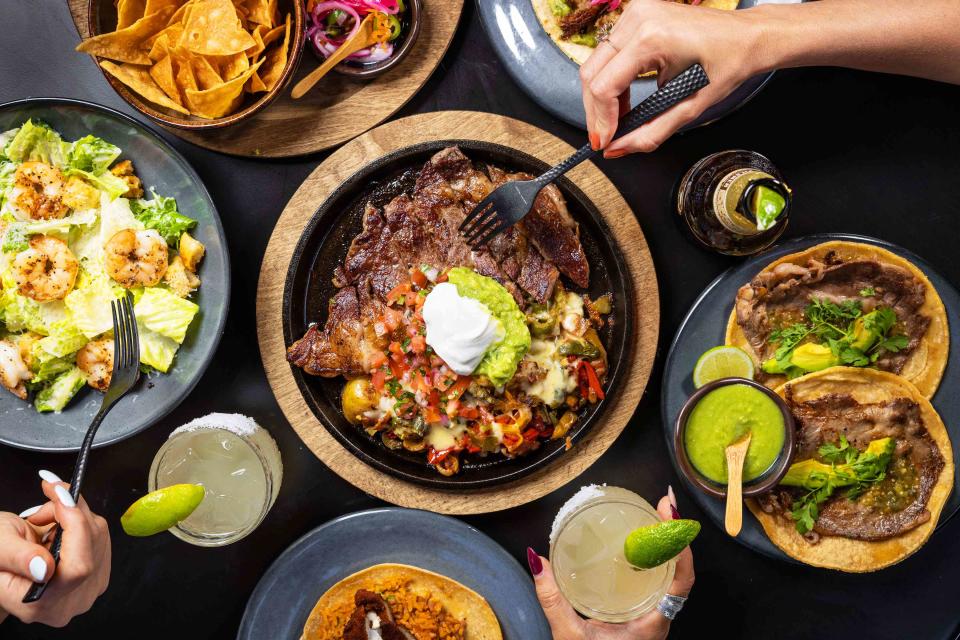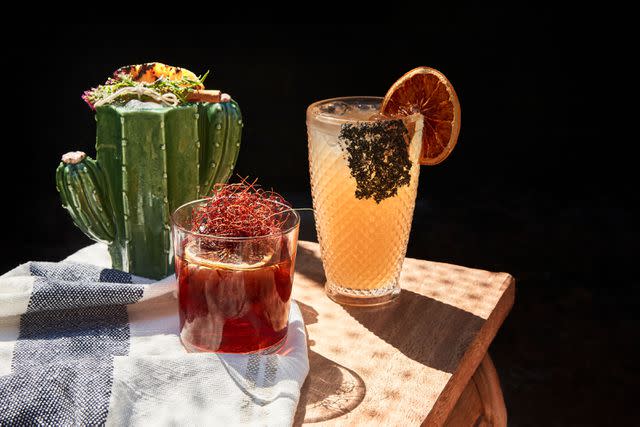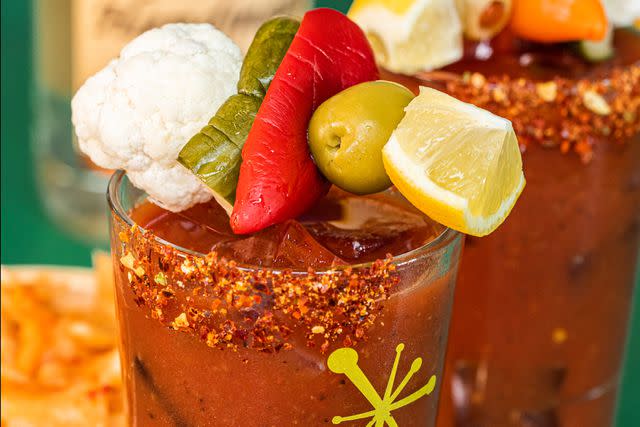Your Favorite Restaurant Might Be Part of a 'Secret Chain'
Mine is. It's cool.

Courtesy of La Popular
The buzz was unbearable. I wouldn’t have ventured that far south without it. But on a Monday evening, I ratcheted up the AC in my car so high that something started leaking out the bottom and onto the steaming asphalt. Still, I kept driving through the oppressive Texas heat, 20 minutes from the heart of Austin, where I live. I just had to try this Mexico City import I’d been hearing about everywhere, and besides, they’d have cold air there.
When my GPS told me I'd arrived, it turned out I hadn’t. I walked circles around the strip mall several times, looking for the entrance. Somehow, I ended up in a small man-made grove of oak trees, ankle deep in wood chips.
But when I spotted its neon sign mocking me from the other end of the complex, there was no more mistaking it. The interior of La Popular is so modern and delightful, I no longer felt like I was in an Austin strip mall anymore. I wasn’t even in Texas. Instead, I was somewhere entirely different. Was it Downtown Los Angeles, pulling up a seat at Enrique Olvera’s Damian? Or was it Mexico City itself? No, the chip splinters clinging to my socks reminded me, you’re just dehydrated.
But the dark interior was the perfect place to escape the heat, and it was brightened only slightly by sconce-decked walls and a disco ball spinning hypnotically overhead. I gazed in awe upon the plants, which arched their way towards the enclosed patio section, wondering all the while who kept them watered and luscious, even amid the sweltering sun. What was their secret? And could they help me with my plants, which die from dehydration on a weekly basis?
As I flopped the laminated menu around in my hand, I began to wonder if I made a mistake. Everything on it looked mundane, and seemed to be there only to meet expectations of what a Mexican restaurant is and should serve. Things like nachos, guacamole, carne asada, and wait, is that chicken Milanese?
But when the first morsel came, I knew there was more magic going in this corner of the city than plant-care. I began blabbering to my partner (who was still mad at me about getting lost) through a mouthful of tortilla chips that this was exactly what we were missing: a great neighborhood restaurant where you could just pop in for delicious food sans reservation. If people didn’t want to drive out here and look a little closer, it was their loss.
It only got better. A salsa quartet hit the table with ramekins ranging from mild to “take a bottle home for $8” to “weeping” and I found myself guzzling down each one — manners be damned. Then slices of al pastor swooped in, which I couldn’t stop stuffing into the warm corn tortillas that seemed to hover from table to table, kept warm inside of tight-woven baskets.
The ribeye taco was where things really took a turn. When the waiter dropped it off, I looked around like I was lost. I even thought of crying Garçon! or worse yet, sending it back, something my anxiety would never let me do. But this had to be a mistake. There was no way they would serve a slice of beef, cut as thin as a cardboard box, bleeding onto a corn tortilla with nothing else alongside it. My partner kicked me under the table — she can read minds — and I’m glad she did. It was one of the best tacos I’ve ever eaten.

Courtesy of La Popular
The cocktail menu, like a younger sibling, was not to be outdone. There was a brown sugar skull bobbing, then, lit aflame a mezcal-based drink. Another rum cocktail was poured into a jellyfish coupe glass, then adorned with a smoke bubble tableside. A third, the strangest drink of them all, had me sipping mezcal in a rocks glass stuffed with strands of pepper arranged like a bird’s nest. The flavor profile, which was bitter, spicy, and alcohol-forward, was not the type of cocktail I’d expect a chain restaurant to serve.
Related: Our Readers Declared This Mexico City Hotspot the Best International Restaurant
Oh yeah, I guess I should’ve mentioned this earlier: La Popular is a chain.
It’s not a national chain like Olive Garden or Red Lobster (which you should still eat at, by the way), nor is it a local chain within one city, like Portland, Oregon’s fantastic breakfast mini-chain Fried Egg I’m in Love. It is certainly not a chain in the sense that it has an airport location in addition to its flagship like New Orleans’ Dooky Chase (I’d call this “chain cos-play” more than anything else), and it is not a local hit with a second location in Vegas like DiFara Pizza (wait, what?) — although, it did just open a location (its third) in Vegas, but notably, well off The Strip.
Instead, La Popular is a “secret chain,” a new type of upscale restaurant grouping, which rather than gravitating towards the trifecta of chain locales — Los Angeles, Miami, and New York (and I suppose Vegas counts, too) — focuses instead on smaller, secondary cities, sometimes called “discovery markets,” as its growth driver.
Related: These Are America's Next Great Food Cities
According to Stephen Fabitore, owner of Tupelo Honey Cafe, a self-described upscale, chef-driven, Southern restaurant chain with 21 locations in 13 states including Texas and Oklahoma, these growing cities possess all the elements of life necessary for restaurants like his to thrive. “Here are the key ingredients,” he tells me over the phone. “They have locals with more disposable income than ever, cheaper rent, and a vibrant workforce.”
In order to determine which cities are worthwhile for expansion, Fabitore says he looks at the classic five-mile radius drawings, the demographics, and the psychographics like any good businessperson. But for him, there’s one more data point: cranes in the sky (not the Solange song).
“If people with a lot more money and real estate experience than I have are looking to invest in a city, then I want to have a restaurant there,” Fabitore says. Bottom line, he wants to open in cities that people are migrating to. “We want to be where people want to live.”
But beyond lower overhead costs and the opportunity for growth, there’s one more piece of the strategy, he says. “It’s really important that each location is designed to look like it belongs where it is.”
Related: These Are the World's Next Great Food Cities
No, you’re not the dehydrated one now. That sounds weird, but it makes sense. A chain solely from New York opening in say, Los Angeles, is going to express its East Coast vibes any chance it gets. A mega-chain like Ruby Tuesday has no vibes whatsoever. These “secret chains,” are decidedly somewhere in the middle. They use local elements like craft beer, spirits, and decor to position the restaurant as both being from somewhere and, simultaneously, from nowhere in particular. And it is among this transient state of being, amid this camouflage, if you will, that this genre of restaurants is able to hide themselves in plain sight.
I’ve fallen for this trick not once, but twice.

Courtesy of Snooze
A few weeks after dining at La Popular, I drove up to Fort Worth to visit my partner’s family, and her cousin (a person with turquoise hair who is definitely way cooler than I am), recommended we go to this diner right around the corner from the new house they just bought. I said sure, why not.
When I walked in, I assumed it was just a local greasy spoon. There was a big menu, bigger plates, and a waiter who was snarky with me (all diners need this), along with hot coffee that just did not stop coming. It was a revamped Denny’s designed to cater to the tastes of millennials like myself who grew up eating at Denny’s, but are too cool, pretentious, or both for it now. But Snooze — the diner in question with locations scattered throughout the American Southwest — is better than Denny’s because they also serve Bloody Marys alongside your much-less-greasy-but-just-as-satisfying Grand Slam. In the end, I too would be a regular if I lived around the corner.
Alexia Peters, the VP of Marketing for Eureka! Restaurant Group, which manages La Popular, says that regulars are exactly what they’re after. “We want it to feel like your local place for not just birthday celebrations but even for happy hour,” she says. “We want it to feel like it’s yours.”
This is one reason why La Popular has adapted the Ribeye Taco — that only-meat taco I was confused about earlier — to include accouterments like onions and salsas on the side. “We value what our customers think, and people were definitely surprised when it was just meat and a tortilla,” Peters says. “So we took that feedback, and we changed it.”
Notwithstanding the debate as to whether or not they should have changed this dish (they shouldn’t have, the salsas are already there), there’s one important question I find myself asking. Is this just “small-washing” applied to restaurants?
Yes. Sí. Oui.
But, if it can be applied to fancy olive oil, why not restaurants, too?
There are differences, of course. Unlike a “shoppy shop” grocery store, which looks the same regardless of where you are and stocks the same designer olive oil, “secret chains” are on the opposite end of the spectrum, designed to blend into their surroundings. They are supposed to look and feel familiar — not to each other, but to what you expect to be there, whether that’s a diner, a Chinese restaurant, or a somewhat upscale bistro.
And maybe it’s just me, but I think this form of mimicry is admirable. After all, isn't there a bird (or something) that evolved to detect which flowers are poisonous and which flowers just look like they are? That’s not to say either of the options here — secret chains and regular old restaurants — are poisonous. Just that I clearly can’t tell the difference between them. And here’s the best part: I don’t need to.
For more Food & Wine news, make sure to sign up for our newsletter!
Read the original article on Food & Wine.

